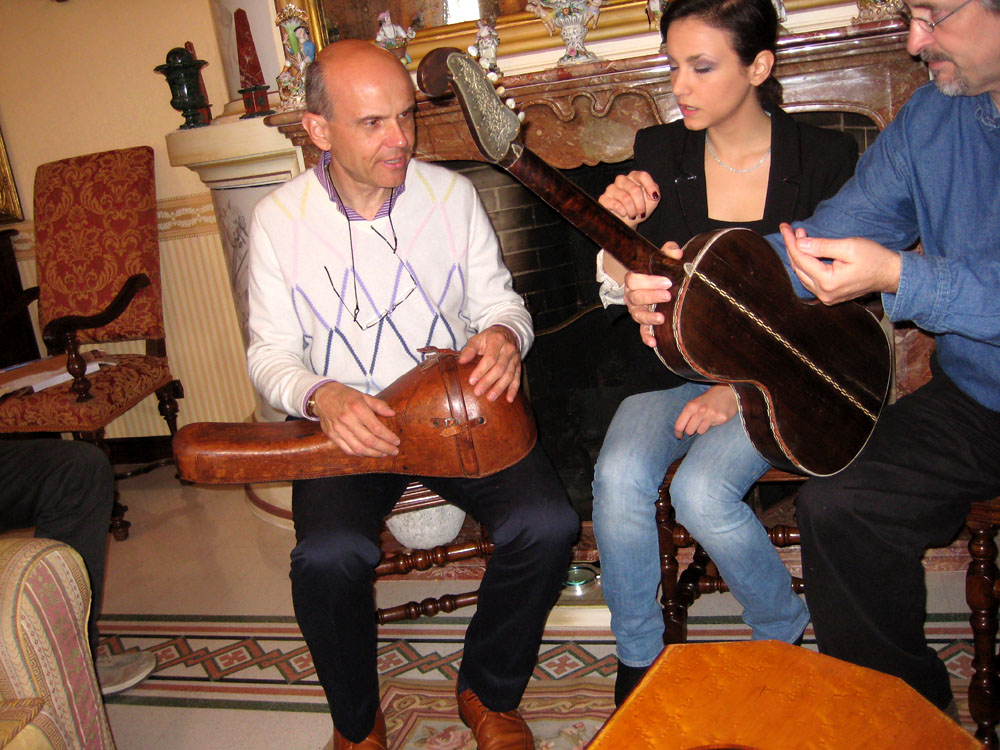 You’ll recall that we left off in the middle of Day 7, when we were invited to the home of Giovanni Accornero, out in the Alexandria countryside.
You’ll recall that we left off in the middle of Day 7, when we were invited to the home of Giovanni Accornero, out in the Alexandria countryside.
You might have noticed that Gianni’s collection is a tiny bit fancier than my own. Well, he’s earned it, I am sure. We were later informed that while he inherited the family pottery business, his real gift was expert study and astute investment in violins, starting while still in his ‘teens (or so the story goes). Really makes me wish I hadn’t blown my allowance on comics. His continuing dedication to preserve, research, and share these treasures through elaborate exhibitions and books is something I also aspire to (along with his budget!). I understand that he and his daughter were starting their own non-profit for this cause as well.
Anyway, after a lavish, leisurely meal at a nearby restaurant (I could do a whole blog just on the menu, but will skip that this time), we went back to the house for one last round…
A stunning guitar case.
The mystery of what’s inside and the unveiling are always the best part.

An equally stunning 1830 Gennaro Fabricatore inside. I (ignorantly) thought the Stauffer-style headstock was a later alteration – but no, this is apparently one of 4 known with this headstock in place of Fabricatore’s usual.

And the back. Incredible.

Another Gennaro Fabricatore, but with a pedigree. The initials “M” & “G” straddle the inlay above the endpin. Yep, Mauro Giuliani’s personal instrument. Giuliani is concerned by many to be the world’s first important guitar virtuoso. A spectacular guitar with the beautiful tone of its 1809 pedigree. Look, Mom – I’m a virtuoso! (I look like I’m about to play “Louie, Louie” though…)

And back.
Not sure why I’m laughing (perhaps I did try to play L,L?)

“M.G.” initials on the fully painted, well-used case

A compartment underneath would hold Giuliani’s music and strings

But pull a hidden lever and a secret panel opens. This they imagine is where Giuliani hid his work-in-progress music that he didn’t want anyone to see.

Another impecaably beautiful case.
That’s Gianni’s daughter Giulia, who was very helpful in translating between two “brothers in guitar” who otherwise could hardly understand a word each other said.

Yes, the inlaid crown on the case means that this was indeed the guitar of Queen Margherita of Italy (1878-1900).

This is definitely not one I’d want to leave with any of my inevitable acrylic nail scratches…
Made personally for the Queen consort by Pasquale Vinaccia of Naples in 1880 (first order of Royal business? Order a guitar!).

I love this headstock

Spectacular, beautiful and not overly ostentatious, in immaculate condition.

Examining the back while Gianni pulls out the Queen’s mandolin. Get ready.

Also by Vinaccia, built I think at the same time.
Obviously the Queen said “…and don’t skimp on the bling.”


Ivory and tortoiseshell, if I’m not mistaken…


One more Fabricatore, this one commissioned by the great violin virtuoso, Paganini, who was also a virtuoso guitar player. I’m not clear if this may have been his or one of his student’s.

Now things are going to get serious…the Baroque guitar room.

Just some of the cases were nicer than any instrument I own!

Giorgio Sellas, Venice, 1639…breathtaking, and in near immaculate condition

Jean Voboam, Paris, 1680…you might see this in a book if you’re lucky. Possibly in a museum if you travel far and wide. Holding something of such quality this ancient and delicate and pristine is completely indescribable. How can I possibly thank Gianni for allowing us this private audience (and letting klutzy me examine such a treasure)?

A beautiful table with a presentation of mandolinos

A gorgeous mandoloncello

Gianni had this small guitar book lying about, so I thumbed through and found this. Semi-important, as it tells us that, at least in Milan in 1923, the Italians were using a simple “guitar with basses” for a common theorboed harp guitar, but for a hollow arm Monzino, were using the equivalent of our American “harp-guitar.”
Next (unphotographed), Gianni wanted to show me some of his more modern instruments. These included a Fleta played for years by John Williams. I have no idea why anyone would let go of such a thing, no matter how “played in.” This was the most amazing guitar I have ever personally experienced in some 5 decades of guitar exploration – it literally played itself. The sound exploded out of it with the slightest touch. Seriously, it was supernaturally responsive in ways that defy the laws of physics. Goosebumps just recalling the visceral reaction….
Also an amazing guitar (lost the notes, sorry, forget the maker) was one of Barrios’ personal instruments. Gianni had a reproduction fretboard installed, but had the original of course. This was worn beyond belief, for, as you know, Barrios used steel strings on his classical guitars. Fascinating to see the remnants after untold years of virtuoso playing!
And now we (meaning I) had definitely pushed the limits of hospitality. As we were wrapping up, Gianni asked me if I was interested in seeing a 7-string guitar. I asked, “What, you mean Russian?” He said, “No, by Lacôte.” “But of course – that’s a harp guitar,” I cried! So one more case came out…but it was a huge double case – containing not only the offered heptacorde, but a near-mint Brazilian rosewood décacorde!

Life does just not get any better.
…I’ll take one of each.






